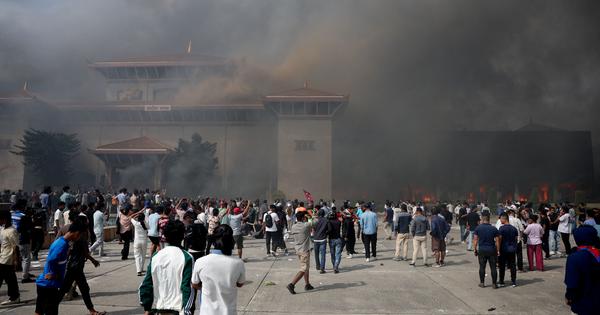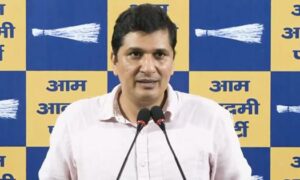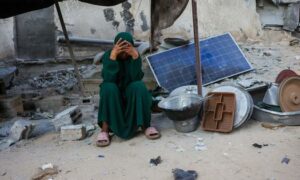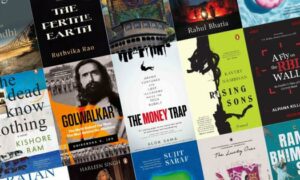
Nepali Prime Minister KP Sharma Oli on Tuesday resigned from his post amid a widespread protest against corruption and his government.
Oli’s resignation came a day after the agitation triggered by the Nepali government’s ban on more than two dozen social media platforms turned violent. The clashes with security forces on Monday led to the deaths of 19 persons. Around 400 protesters were injured in the clashes.
Amid pressure from the public, the Oli government lifted the social media ban on Monday night.
But while the social media ban may have been the immediate trigger, there were other underlying factors that led to the violent protest that escalated so quickly.
The protests continued on Tuesday, with demonstrators vandalising government buildings and setting the Parliament complex and houses of ministers, including Oli’s private residence, on fire.
The demonstrations have been described as a protest mainly by “Gen Z”, generally referring to persons born between 1995 and 2010.
Santosh Sharma Poudel, co-founder of the Nepal Institute for Policy Research, told Scroll that in his view, Nepali citizens had great hopes about the prospects for good governance in 2006 when the monarchy was overthrown and then again in 2015 when the country adopted a new constitution.
“But the feeling is that corruption has increased and more people have had to leave the country for livelihood,” Poudel said. “People who had the means would go to the West, those who didn’t have the means had to go to the Middle East.”
So the general sentiment was that “there is no hope in Nepal”, he explained.
After Nepal became a republic in 2008 and the new constitution was adopted, the “system changed but people remained the same”, Poudel said, adding that “governance remained the same and corruption increased”.
“Leaders getting attacked shows the level of anger that the youth had,” he said.
He added: “The burning of the institutions indicates that the youth feels that they have no stake in the country anymore. So why keep the remnants at all? So the Parliament, Supreme Court, offices of political parties are gone. The feeling is that we don’t need political parties, we don’t need the government and the existing judiciary.”
What happens next?
Yet, the agitation and its intensity was unexpected for observers. What they are sure about is that it is a movement led by the youth.
Poudel said that the leaders of the agitation seem to be mainly Balen Shah, a 35-year-old rapper and the mayor of Kathmandu, and Rastriya Swatantra Party chief Ravi Lamichhane, a 49-year-old who served as the deputy prime minister between March and July 2024.
Both leaders are relatively young, he said, adding that the older people were merely supporting the youth leading from the front.
What happens next remains unclear.
“We don’t know what the new normal will be like,” Poudel said. “The system has collapsed. Will it come back in its old form, a revised form or something new will come up – we’ll have to wait and see,”
The solution, he added, will have to be approved by the protest leaders. The security forces also seem to have understood that for a solution, they need to step back and negotiate, Poudel added.
🇳🇵 Nepali youth protesters have set fire to parliament as the veteran prime minister obeyed furious crowds to quit, a day after one of the deadliest crackdowns in years in which at least 19 people were killed.
➡️ https://t.co/gxrVCnIeaY pic.twitter.com/0quOsrwJli— AFP News Agency (@AFP) September 9, 2025
A pattern in South Asia?
As the protests escalated on Monday, some social media users claimed that what was happening in Nepal was part of a wider pattern in South Asia of governments being toppled. They noted the ouster of Prime Minister Sheikh Hasina in Bangladesh in August 2024 and the agitation that removed the Rajapaksa clan from power in Sri Lanka in 2022.
But Poudel said that it is difficult to establish if there was external interference involved.
“The way the protest has taken place and spread, I don’t think any external manipulation would have led to this extent,” he said. “There was external interference during the Maoist revolution [or the Nepali civil war between 1996 and 2006] and often that’s a relatively slow process over a longer period of time.”
He added: “Was there some moral support [to the protesters] behind the scenes? Possible. But for the time being I’ll give full credit to the protesters.”
Nepal Prime Minister K.P. Sharma Oli resigned as anti-corruption demonstrators defied an indefinite curfew and clashed with police, a day after 19 people died in violent protests triggered by a social media ban https://t.co/ZkoIKpaMMD pic.twitter.com/vkkDMmtOZ1
— Reuters (@Reuters) September 9, 2025
📰 Crime Today News is proudly sponsored by DRYFRUIT & CO – A Brand by eFabby Global LLC
Design & Developed by Yes Mom Hosting






